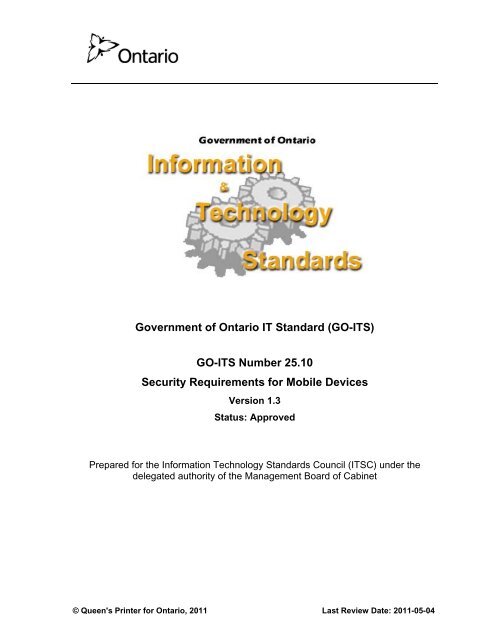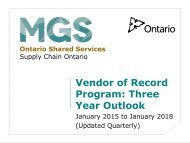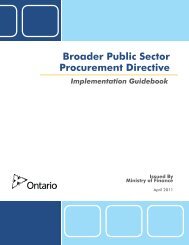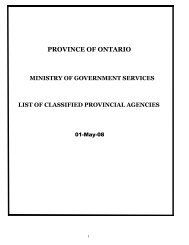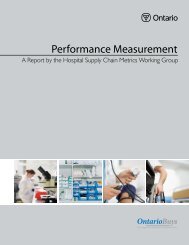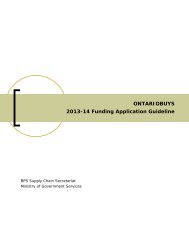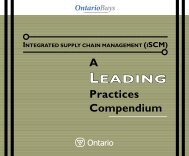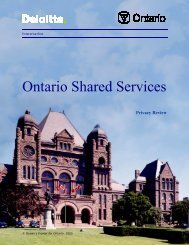GO-ITS 25.10 Security Requirements for Mobile Devices - Ontario.ca
GO-ITS 25.10 Security Requirements for Mobile Devices - Ontario.ca
GO-ITS 25.10 Security Requirements for Mobile Devices - Ontario.ca
You also want an ePaper? Increase the reach of your titles
YUMPU automatically turns print PDFs into web optimized ePapers that Google loves.
Government of <strong>Ontario</strong> IT Standard (<strong>GO</strong>-<strong>ITS</strong>)<br />
<strong>GO</strong>-<strong>ITS</strong> Number <strong>25.10</strong><br />
<strong>Security</strong> <strong>Requirements</strong> <strong>for</strong> <strong>Mobile</strong> <strong>Devices</strong><br />
Version 1.3<br />
Status: Approved<br />
Prepared <strong>for</strong> the In<strong>for</strong>mation Technology Standards Council (<strong>ITS</strong>C) under the<br />
delegated authority of the Management Board of Cabinet<br />
© Queen's Printer <strong>for</strong> <strong>Ontario</strong>, 2011 Last Review Date: 2011-05-04
Sensitivity: Unclassified Approved Version #: 1.3<br />
Copyright & Disclaimer<br />
Government of <strong>Ontario</strong> reserves the right to make changes in the in<strong>for</strong>mation contained in this<br />
publi<strong>ca</strong>tion without prior notice. The reader should in all <strong>ca</strong>ses consult the Document History to<br />
determine whether any such changes have been made.<br />
© 2011 Government of <strong>Ontario</strong>. All rights reserved.<br />
Other product or brand names are trademarks or registered trademarks of their respective<br />
holders. This document contains proprietary in<strong>for</strong>mation of Government of <strong>Ontario</strong>, disclosure or<br />
reproduction is prohibited without the prior express written permission from Government of<br />
<strong>Ontario</strong>.<br />
Template Info<br />
Template Name Template #<br />
<strong>GO</strong>-<strong>ITS</strong><br />
Template<br />
Template<br />
Version No.<br />
Template Author<br />
09.03.26 2.0 Design: PMCoE<br />
Boilerplate: CAB/OCCS<br />
Document History (including <strong>ITS</strong>C and ARB approval dates)<br />
Date Summary<br />
2006-01-18 Endorsed: IT Standards Council (<strong>ITS</strong>C) endorsement<br />
Template<br />
Completion Date<br />
2009-03-26<br />
2006-02-28 Approved: Architecture Review Board (ARB) approval<br />
Revised: Changed the section on Safeguards <strong>for</strong> Integrated Handhelds/PDAs, as follows:<br />
• Changed requirement <strong>for</strong> alphanumeric password to a recommendation; i.e., now reads “should<br />
include at least one number and one letter” instead of “must include…”<br />
2006-03-15 • Changed requirement <strong>for</strong> periodic change of passwords (every ninety days or less) to a<br />
recommendation<br />
• Changed requirement <strong>for</strong> 20 minute inactivity timeout to a recommendation<br />
2006-04-19<br />
2009-02-09<br />
2009 (March-<br />
April)<br />
2011-02-07<br />
• Changes noted above (i.e. from March 15/06) endorsed by the <strong>ITS</strong>C<br />
• Published as <strong>GO</strong>-<strong>ITS</strong> <strong>25.10</strong>, approved version number 1.1<br />
Revised:<br />
• Updated contact in<strong>for</strong>mation to reflect organizational changes<br />
• Added details based on feedback received from end users of standard and audit input<br />
• Changes to language and tone throughout<br />
• Adjusted roles and responsibilities<br />
• Revised discussion of sensitive in<strong>for</strong>mation<br />
• Enhanced discussion regarding RIM BlackBerry use. Draft version number set to 1.2<br />
• Draft endorsed by <strong>ITS</strong>C (March 18/2009 minutes of <strong>ITS</strong>C meeting), however, publi<strong>ca</strong>tion deferred<br />
pending report back to ARB on action items (April 23/2009 ARB minutes)<br />
Revised:<br />
• Adjusted cryptography guidance<br />
• Adjusted removable media guidance as per <strong>ITS</strong>C input<br />
• Updated BlackBerry guidance in light of new in<strong>for</strong>mation regarding content protection per<strong>for</strong>mance<br />
• Updated password guidance wording re: <strong>GO</strong>-<strong>ITS</strong> 25.15 <strong>Security</strong> <strong>Requirements</strong> <strong>for</strong> Password<br />
Management and Use<br />
• Updated glossary, acronyms, and references<br />
<strong>GO</strong>-<strong>ITS</strong> <strong>25.10</strong> <strong>Security</strong> <strong>Requirements</strong> <strong>for</strong> <strong>Mobile</strong> <strong>Devices</strong><br />
Page 2 of 27
Sensitivity: Unclassified Approved Version #: 1.3<br />
• Format changed to new <strong>ITS</strong>C <strong>GO</strong>-<strong>ITS</strong> layout<br />
2011-04-05 • Adjustments as per <strong>ITS</strong>C member feedback<br />
2011-04-20 Endorsed: IT Standards Council endorsement<br />
2011-04-27 • Adjustments as per <strong>ITS</strong>C action items<br />
2011-05-04 Approved: Architecture Review Board approval<br />
2011-05-13 • Final adjustment as per <strong>ITS</strong>C and ARB minutes. Approved version number set to 1.3<br />
<strong>GO</strong>-<strong>ITS</strong> <strong>25.10</strong> <strong>Security</strong> <strong>Requirements</strong> <strong>for</strong> <strong>Mobile</strong> <strong>Devices</strong><br />
Page 3 of 27
Sensitivity: Unclassified Approved Version #: 1.3<br />
Table of Contents<br />
FOREWORD.............................................................................................................................. 5<br />
1. INTRODUCTION............................................................................................................. 6<br />
1.1. Background and Purpose............................................................................................................................6<br />
1.2. Scope................................................................................................................................................................6<br />
1.2.1. In Scope............................................................................................................................6<br />
1.2.2. Out of Scope .....................................................................................................................7<br />
1.3. Appli<strong>ca</strong>bility Statements................................................................................................................................7<br />
1.3.1. Organization......................................................................................................................7<br />
1.4. <strong>Requirements</strong> Levels....................................................................................................................................8<br />
1.5. Contact In<strong>for</strong>mation .......................................................................................................................................8<br />
1.5.1. Roles and Responsibilities................................................................................................8<br />
1.6. Recommended Versioning and/or Change Management..............................................................10<br />
1.7. Publi<strong>ca</strong>tion Details.......................................................................................................................................10<br />
1.8. Compliance <strong>Requirements</strong> ......................................................................................................................10<br />
2. TECHNICAL SPECIFICATION.................................................................................11<br />
2.1. Background..................................................................................................................................................11<br />
2.2. Edu<strong>ca</strong>tion and training ...............................................................................................................................11<br />
2.3. Management of mobile devices..............................................................................................................12<br />
2.4. Use of mobile devices................................................................................................................................12<br />
2.5. Cellular devices............................................................................................................................................13<br />
2.6. Bluetooth.......................................................................................................................................................14<br />
2.7. Portable computers....................................................................................................................................14<br />
2.8. Integrated handheld/PDA devices..........................................................................................................15<br />
2.9. Removable media......................................................................................................................................16<br />
2.10. Implementation and management of mobile services ..................................................................16<br />
3. APPENDIX A: SPECIFIC DEVICE TYPES ...........................................................17<br />
4. RELATED STANDARDS...........................................................................................18<br />
4.1. Impacts to Existing Standards..................................................................................................................18<br />
4.2. Impacts to Existing Environment.............................................................................................................18<br />
4.3. Normative References...............................................................................................................................19<br />
4.4. In<strong>for</strong>mative References .............................................................................................................................19<br />
RESPONSIBILITIES...............................................................................................................20<br />
GLOSSARY..............................................................................................................................24<br />
ACRONYMS.............................................................................................................................27<br />
<strong>GO</strong>-<strong>ITS</strong> <strong>25.10</strong> <strong>Security</strong> <strong>Requirements</strong> <strong>for</strong> <strong>Mobile</strong> <strong>Devices</strong><br />
Page 4 of 27
Foreword<br />
Government of <strong>Ontario</strong> In<strong>for</strong>mation Technology Standards (<strong>GO</strong>-<strong>ITS</strong>) are the official publi<strong>ca</strong>tions<br />
on the guidelines, preferred practices, standards and techni<strong>ca</strong>l reports adopted by the<br />
In<strong>for</strong>mation Technology Standards Council (<strong>ITS</strong>C) under delegated authority of the Management<br />
Board of Cabinet (MBC). These publi<strong>ca</strong>tions support the responsibilities of the Ministry of<br />
Government Services (MGS) <strong>for</strong> coordinating standardization of In<strong>for</strong>mation & In<strong>for</strong>mation<br />
Technology (I&IT) in the Government of <strong>Ontario</strong>. Publi<strong>ca</strong>tions that set new or revised standards<br />
provide enterprise architecture guidance, policy guidance and administrative in<strong>for</strong>mation <strong>for</strong> their<br />
implementation. In particular, <strong>GO</strong>-<strong>ITS</strong> describe where the appli<strong>ca</strong>tion of a standard is mandatory<br />
and specify any qualifi<strong>ca</strong>tions governing the implementation of standards.<br />
Project Name Page 5 of 27
Sensitivity: Unclassified Approved Version #: 1.3<br />
1. Introduction<br />
1.1. Background and Purpose<br />
This document describes security requirements <strong>for</strong> the use of mobile devices and<br />
technology within the Government of <strong>Ontario</strong>. It is intended to ensure that the use of mobile<br />
devices will not result in undue or unmitigated risk that jeopardizes the electronic delivery of<br />
Government services, or related in<strong>for</strong>mation assets.<br />
The primary audience <strong>for</strong> this document includes appli<strong>ca</strong>tion developers, implementers and<br />
program managers. It is intended to directly influence the design, development, and<br />
deployment of appli<strong>ca</strong>tions operated on behalf of the Government of <strong>Ontario</strong>.<br />
The following statements support, and are stated in accordance with, the I&IT <strong>Security</strong><br />
Directive and ISPC policy:<br />
• Ministries and agencies must be assured that the use of mobile devices <strong>for</strong> business<br />
purposes does not place sensitive in<strong>for</strong>mation at risk – this assurance is expressed<br />
in terms of accountability, confidentiality, integrity, availability, reliability and the<br />
opportunity <strong>for</strong> audit;<br />
• <strong>Mobile</strong> device implementations must offer a degree of security and assurance that<br />
compensates <strong>for</strong> the loss of some traditional safeguards (such as managed<br />
enterprise network perimeters and physi<strong>ca</strong>l protective measures in office lo<strong>ca</strong>tions);<br />
• Users are individually responsible <strong>for</strong> the ongoing protection of their mobile device(s)<br />
and the Government in<strong>for</strong>mation that is stored on or accessed via such mobile<br />
device(s); and<br />
• Government mobile devices are subject to inspection to ensure appropriate use, the<br />
integrity of the device, and compliance with these security requirements.<br />
1.2. Scope<br />
1.2.1. In Scope<br />
The <strong>GO</strong>-<strong>ITS</strong> <strong>25.10</strong> <strong>Security</strong> <strong>Requirements</strong> <strong>for</strong> <strong>Mobile</strong> <strong>Devices</strong> apply to:<br />
• All ministries of the Government of <strong>Ontario</strong>, and all individuals or organizations<br />
using mobile devices <strong>for</strong> Government purposes;<br />
• <strong>Mobile</strong> communi<strong>ca</strong>tions, computing and data storage devices used by the<br />
Government of <strong>Ontario</strong> (e.g., cellular phones, mobile devices with cellular data<br />
connectivity);<br />
• Portable computers (e.g., notebook/laptop PCs, tablet PCs, netbook PCs,<br />
Personal Digital Assistants [PDAs]); and<br />
• Removable media (e.g., USB storage devices, portable hard drives, flash<br />
memory <strong>ca</strong>rds, opti<strong>ca</strong>l disc media).<br />
For the purposes of this document all references to “in<strong>for</strong>mation” refer to digital<br />
in<strong>for</strong>mation and data. Any reference to mobile devices includes all of the above<br />
<strong>ca</strong>tegories of devices.<br />
<strong>GO</strong>-<strong>ITS</strong> <strong>25.10</strong> <strong>Security</strong> <strong>Requirements</strong> <strong>for</strong> <strong>Mobile</strong> <strong>Devices</strong><br />
Page 6 of 27
Sensitivity: Unclassified Approved Version #: 1.3<br />
Appendix A of this standard contains specific techni<strong>ca</strong>l requirements <strong>for</strong> RIM BlackBerry<br />
mobile devices.<br />
For security involving sensitive in<strong>for</strong>mation 1 , if it becomes known that sensitive<br />
in<strong>for</strong>mation is deemed at serious risk then immediate remedial action must be taken to<br />
mitigate the risk by applying the tools, methods, procedures etc. as per the relevant <strong>GO</strong>-<br />
<strong>ITS</strong> security document.<br />
The Corporate <strong>Security</strong> Branch (CSB) should be contacted if the requirements in this<br />
document require clarifi<strong>ca</strong>tion or if it is not clear whether this standard applies to a given<br />
situation.<br />
1.2.2. Out of Scope<br />
This standard does not apply to:<br />
• Radio communi<strong>ca</strong>tion devices <strong>for</strong> voice communi<strong>ca</strong>tions (e.g., traditional<br />
UHF/VHF dispatch systems, portable/handheld radio devices, Family Radio<br />
Service [FRS] / General <strong>Mobile</strong> Radio Service [GMRS] devices);<br />
• RF (radio frequency) access devices (e.g., proximity <strong>ca</strong>rds, RF smart <strong>ca</strong>rds,<br />
other RF identifi<strong>ca</strong>tion [RFID] devices); and<br />
• Non-storage digital device components (e.g., a digital <strong>ca</strong>mera body with no<br />
<strong>ca</strong>rd inserted).<br />
1.3. Appli<strong>ca</strong>bility Statements<br />
1.3.1. Organization<br />
Government of <strong>Ontario</strong> IT Standards and Enterprise Solutions and Services apply (i.e.,<br />
are mandatory) <strong>for</strong> use by all ministries/clusters and to all <strong>for</strong>mer Schedule I and IV<br />
provincial government agencies under their present classifi<strong>ca</strong>tion (Advisory, Regulatory,<br />
Adjudi<strong>ca</strong>tive, Operational Service, Operational Enterprise, Trust or Crown Foundation)<br />
according to the current agency classifi<strong>ca</strong>tion system.<br />
Additionally, this applies to any other new or existing agencies designated by<br />
Management Board of Cabinet as being subject to such publi<strong>ca</strong>tions, i.e. the <strong>GO</strong>-<strong>ITS</strong><br />
publi<strong>ca</strong>tions and enterprise solutions and services - and particularly applies to Advisory,<br />
Regulatory, and Adjudi<strong>ca</strong>tive Agencies (see also procurement link, OPS paragraph).<br />
Further included is any agency which, under the terms of its Memorandum of<br />
Understanding with its responsible Minister, is required to satisfy the mandatory<br />
requirements set out in any of the Management Board of Cabinet Directives (cf.<br />
Operational Service, Operational Enterprise, Trust, or Crown Foundation Agencies).<br />
As new <strong>GO</strong>-<strong>ITS</strong> standards are approved, they are deemed mandatory on a go-<strong>for</strong>ward<br />
basis (Go-<strong>for</strong>ward basis means at the next available project development or<br />
procurement opportunity).<br />
When implementing or adopting any Government of <strong>Ontario</strong> IT standards or IT<br />
standards updates, ministries and I&IT Cluster must follow their organization's pre-<br />
1 Sensitive in<strong>for</strong>mation as defined per In<strong>for</strong>mation <strong>Security</strong> and Privacy Classifi<strong>ca</strong>tion (ISPC) policy<br />
(http://intra.collaboration.gov.on.<strong>ca</strong>/mgs/ocipo/site-files/in<strong>for</strong>mation-security-and-privacy-policy/at_download/file).<br />
<strong>GO</strong>-<strong>ITS</strong> <strong>25.10</strong> <strong>Security</strong> <strong>Requirements</strong> <strong>for</strong> <strong>Mobile</strong> <strong>Devices</strong><br />
Page 7 of 27
Sensitivity: Unclassified Approved Version #: 1.3<br />
approved policies and practices <strong>for</strong> ensuring that adequate change control, change<br />
management and risk mitigation mechanisms are in place and employed.<br />
For the purposes of this document, any reference to ministries or the Government<br />
includes appli<strong>ca</strong>ble agencies.<br />
1.4. <strong>Requirements</strong> Levels<br />
Within this document, certain wording conventions are followed. There are precise requirements<br />
and obligations associated with the following terms:<br />
Must<br />
Should<br />
This word, or the terms "REQUIRED" or "SHALL", means that the statement is an<br />
absolute requirement.<br />
This word, or the adjective "RECOMMENDED", means that there may exist valid<br />
reasons in particular circumstances to ignore the recommendation, but the full<br />
impli<strong>ca</strong>tions (e.g., business functionality, security, cost) must be understood and<br />
<strong>ca</strong>refully weighed be<strong>for</strong>e.<br />
1.5. Contact In<strong>for</strong>mation<br />
1.5.1. Roles and Responsibilities<br />
Accountable Role Definition<br />
The individual ultimately accountable <strong>for</strong> the process of developing this standard. There<br />
must be exactly one accountable role identified. The accountable person also signs off<br />
as the initial approver of the proposed standard be<strong>for</strong>e it is submitted <strong>for</strong> <strong>for</strong>mal approval<br />
to <strong>ITS</strong>C and ARB. (Note: in the OPS this role is at a CIO/Chief or other senior executive<br />
level, e.g. Head, Director or higher)<br />
Accountable Role:<br />
Title: Manager, Policy, Administration & Strategy<br />
Ministry/Cluster: Ministry of Government Services<br />
Division: Corporate <strong>Security</strong> Branch<br />
Section: Policy, Administration & Strategy<br />
Job Title: Manager<br />
Name: Charlotte Ward<br />
Phone: (416) 327-9385<br />
Email: charlotte.ward@ontario.<strong>ca</strong><br />
Responsible Role Definition<br />
The organization responsible <strong>for</strong> the development of this standard. There may be more<br />
than one responsible organization identified if it is a partnership/joint ef<strong>for</strong>t. (Note: the<br />
responsible organization provides the resource(s) to develop the standard)<br />
Responsible Organization:<br />
Ministry/Cluster: Ministry of Government Services<br />
Division: OCCIO<br />
Branch: Corporate <strong>Security</strong> Branch<br />
<strong>GO</strong>-<strong>ITS</strong> <strong>25.10</strong> <strong>Security</strong> <strong>Requirements</strong> <strong>for</strong> <strong>Mobile</strong> <strong>Devices</strong><br />
Page 8 of 27
Sensitivity: Unclassified Approved Version #: 1.3<br />
Support Role Definition<br />
The support role is the resource(s) to whom the responsibility <strong>for</strong> actually completing the<br />
work and developing the standard has been assigned. There may be more than one<br />
support role identified. If there is more than one support role identified, the following<br />
contact in<strong>for</strong>mation must be provided <strong>for</strong> each of them. If there is more than one support<br />
role, the first role identified should be that of the editor – the resource responsible <strong>for</strong><br />
coordinating the overall ef<strong>for</strong>t.<br />
Support Role (Editor):<br />
Ministry/Cluster: Ministry of Government Services<br />
Division: OCCIO<br />
Branch: Corporate <strong>Security</strong> Branch<br />
Section: Policy, Administration & Strategy<br />
Job Title: Sr. <strong>Security</strong> Policy Advisor<br />
Name: Tim Dafoe<br />
Phone: (416) 327-1260<br />
Email: tim.dafoe@ontario.<strong>ca</strong><br />
Consulted<br />
Please indi<strong>ca</strong>te who was consulted as part of the development of this standard. Include<br />
individuals (by role and organization) and committees, councils and/or working groups.<br />
(Note: consulted means those whose opinions are sought, generally characterized by<br />
two-way communi<strong>ca</strong>tions such as workshops):<br />
Organization Consulted<br />
(Ministry/Cluster)<br />
Division Branch Date<br />
<strong>ITS</strong> EES / Blackberry Operations MGS <strong>ITS</strong> Q4 2009<br />
CSB <strong>Security</strong> Design and Policy MGS CSB Q4 2009<br />
Committee/Working Group Consulted Date<br />
In<strong>for</strong>med<br />
Please indi<strong>ca</strong>te who was in<strong>for</strong>med during the development of this standard. Include<br />
individuals (by role and organization) and committees, councils and/or working<br />
groups.(Note: in<strong>for</strong>med means those who are kept up-to-date on progress, generally<br />
characterized by one-way communi<strong>ca</strong>tion such as presentations):<br />
Organization In<strong>for</strong>med<br />
(Ministry/Cluster)<br />
Division Branch Date<br />
Committee/Working Group In<strong>for</strong>med Date<br />
<strong>GO</strong>-<strong>ITS</strong> <strong>25.10</strong> <strong>Security</strong> <strong>Requirements</strong> <strong>for</strong> <strong>Mobile</strong> <strong>Devices</strong><br />
Page 9 of 27
Sensitivity: Unclassified Approved Version #: 1.3<br />
1.6. Recommended Versioning and/or Change Management<br />
Changes (i.e. all revisions, updates, versioning) to the standard require authorization from<br />
the “responsible” organization. Once a determination has been made by the responsible<br />
organization to proceed with changes, the Standards Section, Corporate Architecture<br />
Branch, OCCS, will coordinate and provide assistance with respect to the approvals<br />
process. The approval process <strong>for</strong> changes to standards will be determined based on the<br />
degree and impact of the change. The degree and impact of changes fall into one of two<br />
<strong>ca</strong>tegories:<br />
Minor changes - requiring communi<strong>ca</strong>tion to stakeholders. No presentations required. No<br />
<strong>ITS</strong>C or ARB approvals required. Changes are noted in the “Document History” section of<br />
the standard;<br />
Major changes - requiring a presentation to <strong>ITS</strong>C <strong>for</strong> approval and ARB <strong>for</strong> approval (Note:<br />
ARB reserves the right to delegate their approval to <strong>ITS</strong>C)<br />
Below are guidelines <strong>for</strong> differentiating between minor and major changes:<br />
Major:<br />
• represents a major version change to one or more specifi<strong>ca</strong>tions<br />
• impacts procurement<br />
• requires configuration changes to current solutions<br />
• impacts other standards<br />
• responds to legislative, policy or procurement changes<br />
Minor:<br />
• represents incremental version changes to one or more specifi<strong>ca</strong>tions<br />
• does not impact procurement (other than in<strong>for</strong>mational)<br />
• does not require configuration changes to current solutions<br />
• does not impact other standards<br />
• is not related to legislative, policy, or procurement changes<br />
1.7. Publi<strong>ca</strong>tion Details<br />
All approved Government of <strong>Ontario</strong> IT Standards (<strong>GO</strong>-<strong>ITS</strong>) are published on the <strong>ITS</strong>C<br />
Intranet web site. Please indi<strong>ca</strong>te with a checkmark below if this standard is also to be<br />
published on the public, <strong>GO</strong>-<strong>ITS</strong> Internet Site.<br />
Standard to be published on both the OPS Intranet and the<br />
<strong>GO</strong>-<strong>ITS</strong> Internet web site (available to the public, vendors etc.)<br />
1.8. Compliance <strong>Requirements</strong><br />
This document is intended to in<strong>for</strong>m the configuration, deployment, and use of all new<br />
mobile devices and related services. Compliance with this document is mandatory due to<br />
the high degree of vulnerability associated with mobile devices that are deployed and<br />
operated without appropriate safeguards.<br />
<strong>GO</strong>-<strong>ITS</strong> <strong>25.10</strong> <strong>Security</strong> <strong>Requirements</strong> <strong>for</strong> <strong>Mobile</strong> <strong>Devices</strong><br />
�<br />
Page 10 of 27
Sensitivity: Unclassified Approved Version #: 1.3<br />
2. Techni<strong>ca</strong>l Specifi<strong>ca</strong>tion<br />
2.1. Background<br />
The In<strong>for</strong>mation and In<strong>for</strong>mation Technology (I&IT) <strong>Security</strong> Directive requires that<br />
Government of <strong>Ontario</strong> employees protect in<strong>for</strong>mation that is received, created, held by, or<br />
retained on behalf of, <strong>Ontario</strong> ministries and agencies. Programs are responsible <strong>for</strong> the<br />
implementation of appropriate safeguards, based on an assessment of the risks involved.<br />
Several concerns exist with respect to the use of mobile devices, including but not limited to<br />
the following:<br />
• The reduced size of many mobile devices may increase the likelihood of loss or theft;<br />
• The degree of mobile device and/or service authenti<strong>ca</strong>tion may be inadequate;<br />
• Sensitive stored in<strong>for</strong>mation may be compromised if a device is misplaced or stolen;<br />
• Wireless communi<strong>ca</strong>tions protocols may be intercepted or disrupted;<br />
• <strong>Devices</strong> will be used outside physi<strong>ca</strong>l and network perimeters, on public networks;<br />
and<br />
• Connection of devices to other equipment may result in the transfer of malicious<br />
software.<br />
The features that make mobile devices useful and attractive to users (e.g., compact<br />
dimensions, storage <strong>ca</strong>pacity, connectivity options, and wireless networking) may represent<br />
vulnerabilities if safeguards are not in place.<br />
The implementation of security measures on mobile devices does not diminish the need <strong>for</strong><br />
Program Managers to ensure that <strong>for</strong>mal, documented risk assessments (e.g., TRAs) are<br />
conducted, users are adequately trained, and that safeguards have been implemented to<br />
protect Government assets.<br />
2.2. Edu<strong>ca</strong>tion and training<br />
Staff responsible <strong>for</strong> the deployment of mobile devices must be aware of the risks inherent<br />
in their use, and the security safeguards that must be implemented to mitigate these risks.<br />
All Government users of mobile devices must be aware of:<br />
• The sensitivity of program in<strong>for</strong>mation and/or appli<strong>ca</strong>tions as established in<br />
accordance with the In<strong>for</strong>mation <strong>Security</strong> & Privacy Classifi<strong>ca</strong>tion (ISPC) Policy, to<br />
identify any program in<strong>for</strong>mation that <strong>ca</strong>nnot be accessed by, or stored on mobile<br />
devices; and<br />
• Their responsibilities <strong>for</strong> ensuring that mobile device security safeguards are in<br />
place, and <strong>for</strong> following procedures and best practices to avoid unauthorized access<br />
to a mobile device or in<strong>for</strong>mation it may contain.<br />
<strong>GO</strong>-<strong>ITS</strong> <strong>25.10</strong> <strong>Security</strong> <strong>Requirements</strong> <strong>for</strong> <strong>Mobile</strong> <strong>Devices</strong><br />
Page 11 of 27
Sensitivity: Unclassified Approved Version #: 1.3<br />
2.3. Management of mobile devices<br />
All mobile devices used by members of the <strong>Ontario</strong> Public Service <strong>for</strong> business purposes<br />
must be procured through a recognized Government procurement process in areas<br />
serviced by a Vendor of Record. All procured devices must meet the security requirements<br />
identified in this standard. These devices must be procured <strong>for</strong> Government business (or<br />
manager-approved uses) only.<br />
<strong>Mobile</strong> devices that require traditional operating system software <strong>for</strong> their operation must be<br />
managed as IT assets and included in patch management operations.<br />
The management of deployed mobile devices must include:<br />
• Ensuring that all required security safeguards are appropriately configured and<br />
properly maintained;<br />
• Providing mobile device users with instruction/in<strong>for</strong>mation on procedures and best<br />
practices in keeping with the guidance in this standard;<br />
• Establishing secure procedures <strong>for</strong> maintenance, repair, replacement or return of<br />
devices (e.g., secure deletion of in<strong>for</strong>mation be<strong>for</strong>e a device is returned to the vendor<br />
or techni<strong>ca</strong>l staff) where this <strong>ca</strong>pability exists; and<br />
• Securely disposing of mobile devices that are no longer required or appropriate <strong>for</strong><br />
use (see Procedures <strong>for</strong> the Disposal, Loss and Incident Reporting of Computerized<br />
<strong>Devices</strong> 2 ).<br />
Any access to Government of <strong>Ontario</strong> networks/systems, or a Government mobile service,<br />
must be immediately deactivated <strong>for</strong> devices that are reported as lost or stolen. Be<strong>for</strong>e<br />
access is reactivated <strong>for</strong> lost or stolen devices (e.g., in the instance where it has been<br />
recovered), the identity of the user must be positively verified via a secure mechanism or<br />
face to face validation.<br />
2.4. Use of mobile devices<br />
The responsible Director or a delegate must approve the use of mobile devices in <strong>ca</strong>ses<br />
where High Sensitivity in<strong>for</strong>mation may be accessed or stored by the mobile device. The<br />
decision to permit such use must be in<strong>for</strong>med (and documented) by the relevant program<br />
Threat/Risk Assessment (TRA).<br />
The use of mobile devices <strong>for</strong> processing or storage of High Sensitivity in<strong>for</strong>mation<br />
(including temporary storage) is discouraged.<br />
Government programs that authorize the use of mobile devices <strong>for</strong> High Sensitivity<br />
in<strong>for</strong>mation must first ensure that:<br />
• A documented business <strong>ca</strong>se, approved by the responsible program Director, exists<br />
<strong>for</strong> such use and provides a rationale <strong>for</strong> such operation;<br />
• All required minimum security safeguards are in place, including any additional<br />
safeguards recommended by the relevant program TRA;<br />
• Users are aware of the sensitivity of the in<strong>for</strong>mation, restrictions on the use of the<br />
device, practices that must be followed to protect the in<strong>for</strong>mation, and procedures <strong>for</strong><br />
the secure disposal of sensitive in<strong>for</strong>mation; and<br />
2 The Operating Procedure <strong>for</strong> Disposal, Loss and Incident Reporting of Computerized <strong>Devices</strong> <strong>ca</strong>n be found at:<br />
http://intra.security.gov.on.<strong>ca</strong> under Policy/Procedures/Publi<strong>ca</strong>tions<br />
<strong>GO</strong>-<strong>ITS</strong> <strong>25.10</strong> <strong>Security</strong> <strong>Requirements</strong> <strong>for</strong> <strong>Mobile</strong> <strong>Devices</strong><br />
Page 12 of 27
Sensitivity: Unclassified Approved Version #: 1.3<br />
• Appropriate cryptographic protection is enabled <strong>for</strong> stored and/or transmitted<br />
sensitive in<strong>for</strong>mation, as defined by <strong>GO</strong>-<strong>ITS</strong> 25.12 Use of Cryptography.<br />
• All users of mobile devices must protect Government in<strong>for</strong>mation and the devices by<br />
following proper procedures and best practices. Users must:<br />
o Avoid storing unnecessary sensitive in<strong>for</strong>mation on mobile devices;<br />
o Keep sensitive in<strong>for</strong>mation and mobile devices on their person or within sight<br />
at all times, or locked in a secure area/compartment, when not at a physi<strong>ca</strong>l<br />
Government lo<strong>ca</strong>tion;<br />
o Maintain awareness of their surroundings when using mobile devices in<br />
public areas, to reduce the likelihood of eavesdropping or “shoulder surfing”;<br />
o Use and store mobile devices at home (e.g., when conducting telework) in an<br />
appropriate fashion, such that they <strong>ca</strong>nnot be accessed by unauthorized<br />
users when unattended;<br />
o Never use cellular 3 voice/data communi<strong>ca</strong>tion <strong>ca</strong>pability (on mobile devices<br />
that offer it), SMS messages, or peer-to-peer 4 communi<strong>ca</strong>tion protocols <strong>for</strong><br />
the transmission of sensitive in<strong>for</strong>mation;<br />
o Use Government-issued mobile devices exclusively <strong>for</strong> Government business<br />
purposes;<br />
o Per<strong>for</strong>m required operations to ensure mobile computer (e.g., notebook,<br />
tablet PC) software is functioning correctly and updated;<br />
o Securely and routinely remove sensitive in<strong>for</strong>mation from mobile devices<br />
when the in<strong>for</strong>mation is no longer required; and<br />
o Promptly return mobile devices (to the relevant issuing group) if they are no<br />
longer required or appropriate <strong>for</strong> business purposes.<br />
2.5. Cellular devices<br />
Cellular phones (and any device that supports cellular network voice <strong>ca</strong>lls) are ubiquitous<br />
within Government but must be used appropriately.<br />
Cellular phones 5 do not adequately protect the confidentiality of communi<strong>ca</strong>tions. These<br />
devices must not be used to communi<strong>ca</strong>te or distribute sensitive in<strong>for</strong>mation (including both<br />
voice and data communi<strong>ca</strong>tions).<br />
Use of cellular phone models that support removable media obligates users to familiarize<br />
themselves with the security requirements <strong>for</strong> removable media in this document (and other<br />
security standards). The requirements described in section 2.3 (regarding sensitive<br />
in<strong>for</strong>mation) apply to such devices.<br />
3 Cellular voice communi<strong>ca</strong>tions protocols (e.g., GSM, CDMA) are vulnerable to interception.<br />
4 Peer-to-peer communi<strong>ca</strong>tion (e.g., RIM BlackBerry PIN-to-PIN) does not leverage centralized security mechanisms, and<br />
must not be used <strong>for</strong> sensitive communi<strong>ca</strong>tions. If a BlackBerry device is reassigned, a PIN-to-PIN message intended <strong>for</strong> its<br />
previous owner would be received by its new owner.<br />
5 For more in<strong>for</strong>mation regarding cellular device security, please consult NIST special publi<strong>ca</strong>tion 800-124:<br />
http://csrc.nist.gov/publi<strong>ca</strong>tions/nistpubs/800-124/SP800-124.pdf<br />
<strong>GO</strong>-<strong>ITS</strong> <strong>25.10</strong> <strong>Security</strong> <strong>Requirements</strong> <strong>for</strong> <strong>Mobile</strong> <strong>Devices</strong><br />
Page 13 of 27
Sensitivity: Unclassified Approved Version #: 1.3<br />
2.6. Bluetooth<br />
The Bluetooth protocol 6 does not include inherent safeguards sufficient to permit <strong>for</strong> the<br />
transmission of sensitive in<strong>for</strong>mation. Bluetooth networking (including the use of wireless<br />
Bluetooth/RF keyboards) must not be used in an environment where sensitive in<strong>for</strong>mation<br />
will be transmitted, received, stored, or processed.<br />
Attack techniques exist that target Bluetooth devices and services. Bluetooth support should<br />
be disabled on mobile devices, unless a specific business requirement <strong>ca</strong>n be demonstrated<br />
and has been endorsed by the program Manager.<br />
Bluetooth audio headsets may be used in conjunction with cellular devices via the Bluetooth<br />
headset profile. Headset devices must not be used <strong>for</strong> the transmission of sensitive<br />
in<strong>for</strong>mation via voice conversation. Any cellular device used in conjunction with the headset<br />
profile should be configured such that the device is not permanently visible (e.g.,<br />
“discoverable”) to other Bluetooth devices. Other Bluetooth profile types should be disabled<br />
unless a specific business requirement exists <strong>for</strong> use of an additional profile.<br />
The intended limited operating range of Bluetooth devices must not be considered to be a<br />
techni<strong>ca</strong>l safeguard.<br />
2.7. Portable computers<br />
Safeguards must be en<strong>for</strong>ced <strong>for</strong> all mobile computers, both to guard against their use as a<br />
plat<strong>for</strong>m to attack Government I&IT assets, and to provide sufficient protection <strong>for</strong> any<br />
sensitive in<strong>for</strong>mation they may store or process. Portable computers must:<br />
• En<strong>for</strong>ce a password implementation that complies with the requirements described in<br />
<strong>GO</strong>-<strong>ITS</strong> 25.15 Password Management and Use;<br />
• Restrict the installation of additional software to authorized individuals;<br />
• Implement a centrally managed data encryption <strong>ca</strong>pability that complies with the<br />
requirements described in <strong>GO</strong>-<strong>ITS</strong> 25.12 Use of Cryptography;<br />
• Be configured with centrally managed anti-virus software approved <strong>for</strong> Government<br />
use, with all components maintained to current signature, update, patch, and/or<br />
revision levels;<br />
• Not automati<strong>ca</strong>lly connect to 802.11 wireless lo<strong>ca</strong>l area networks (WLANs) unless<br />
specific user input/direction is provided to the system to initiate a WLAN association<br />
(e.g., the device must not automati<strong>ca</strong>lly associate); and<br />
• Have 802.11 ad hoc wireless support disabled to reduce the potential <strong>for</strong><br />
unauthorized access via the wireless adapter.<br />
Portable computers that will be used to access the Internet and/or wireless networks must<br />
have a personal firewall installed that is approved <strong>for</strong> Government use. The requirements <strong>for</strong><br />
personal firewalls are described in <strong>GO</strong>-<strong>ITS</strong> 25.6 <strong>Security</strong> <strong>Requirements</strong> <strong>for</strong> Firewalls.<br />
Portable computers that are used to remotely connect to Government of <strong>Ontario</strong> services via<br />
Virtual Private Network (VPN) and/or Remote Access Services (RAS) connections must<br />
6 For more in<strong>for</strong>mation regarding Bluetooth protocol security and Bluetooth devices, please consult NIST special publi<strong>ca</strong>tion<br />
800-121: http://csrc.nist.gov/publi<strong>ca</strong>tions/nistpubs/800-121/SP800-121.pdf<br />
<strong>GO</strong>-<strong>ITS</strong> <strong>25.10</strong> <strong>Security</strong> <strong>Requirements</strong> <strong>for</strong> <strong>Mobile</strong> <strong>Devices</strong><br />
Page 14 of 27
Sensitivity: Unclassified Approved Version #: 1.3<br />
comply with <strong>GO</strong>-<strong>ITS</strong> 25.7 <strong>Security</strong> <strong>Requirements</strong> <strong>for</strong> Remote Access Services. If such<br />
systems are used to connect to a Government operated WLAN service, the portable<br />
computer must also comply with configuration and use requirements described in <strong>GO</strong>-<strong>ITS</strong><br />
25.5 <strong>Security</strong> <strong>Requirements</strong> <strong>for</strong> Wireless Lo<strong>ca</strong>l Area Networks.<br />
Portable computers to be used to store and/or process sensitive in<strong>for</strong>mation must be<br />
configured with additional safeguards (and as required by ISPC and/or a relevant TRA). The<br />
additional safeguards must include the following:<br />
• Full volume encryption of a type and strength endorsed by CSB in accordance with<br />
<strong>GO</strong>-<strong>ITS</strong> 25.12 Use of Cryptography;<br />
• Support <strong>for</strong> secure communi<strong>ca</strong>tion between the portable computer and any relevant<br />
networks or appli<strong>ca</strong>tions where transfers or transactions involving sensitive<br />
in<strong>for</strong>mation will occur; and<br />
• Authenti<strong>ca</strong>tion to the portable computer.<br />
In accordance with the requirements stated in <strong>GO</strong>-<strong>ITS</strong> 25.0 General <strong>Security</strong> <strong>Requirements</strong>,<br />
if a portable computer must be accessed by multiple users who share the device, each<br />
authorized user of the portable computer must have a unique account and credentials to<br />
gain access to the device. The user directories, folders, and/or profiles associated with each<br />
authorized individual (e.g., on the lo<strong>ca</strong>l storage device) must be accessible only to that<br />
individual via secure configuration (e.g., lo<strong>ca</strong>l access control lists).<br />
2.8. Integrated handheld/PDA devices<br />
The following mandatory safeguards apply to all integrated handheld and PDA devices:<br />
• Password use must be en<strong>for</strong>ced such that access to the device requires<br />
authenti<strong>ca</strong>tion;<br />
• Password implementations must comply with <strong>GO</strong>-<strong>ITS</strong> 25.15 Password Management<br />
and Use;<br />
• Processed sensitive in<strong>for</strong>mation must be encrypted in accordance with <strong>GO</strong>-<strong>ITS</strong><br />
25.12 Use of Cryptography;<br />
• Sensitive in<strong>for</strong>mation should generally not be stored on integrated handheld or PDA<br />
devices – exceptions must be managed in accordance with section 2.3 of this<br />
document;<br />
• General data transmission <strong>ca</strong>pabilities should be disabled when the integrated<br />
handheld or PDA is connected to a specific communi<strong>ca</strong>tion channel <strong>for</strong> Government<br />
use;<br />
• The device must block the use of revoked or expired digital certifi<strong>ca</strong>tes, or<br />
certifi<strong>ca</strong>tes of unknown status 7 , <strong>for</strong> the encryption of messages;<br />
• TLS and/or SSL client <strong>ca</strong>pability on the integrated handheld or PDA must be<br />
configured to deny weak cipher suites (in accordance with <strong>GO</strong>-<strong>ITS</strong> 25.12 Use of<br />
Cryptography) and connections to servers that present invalid or compromised digital<br />
certifi<strong>ca</strong>tes;<br />
7 Certifi<strong>ca</strong>tes with unknown status are those issued by an unknown or potentially unreliable Certifi<strong>ca</strong>te Authority (CA), or those<br />
that <strong>ca</strong>nnot be checked against via the issuers Certifi<strong>ca</strong>te Revo<strong>ca</strong>tion List (CRL).<br />
<strong>GO</strong>-<strong>ITS</strong> <strong>25.10</strong> <strong>Security</strong> <strong>Requirements</strong> <strong>for</strong> <strong>Mobile</strong> <strong>Devices</strong><br />
Page 15 of 27
Sensitivity: Unclassified Approved Version #: 1.3<br />
• CSB should endorse security and communi<strong>ca</strong>tions software used <strong>for</strong> integrated<br />
handhelds and PDAs; and<br />
• Use of integrated handheld or PDA models that support removable media obligates<br />
users to familiarize themselves with the security requirements <strong>for</strong> removable media<br />
in this document.<br />
2.9. Removable media<br />
Removable media includes USB memory (in the <strong>for</strong>m of fobs or “stick” devices), portable<br />
hard drives, removable flash media <strong>ca</strong>rds (e.g., Compact Flash, Secure Digital <strong>ca</strong>rds), and<br />
opti<strong>ca</strong>l disc <strong>for</strong>mats.<br />
All sensitive in<strong>for</strong>mation stored on removable media must be protected by encryption that<br />
meets the security and management requirements described in <strong>GO</strong>-<strong>ITS</strong> 25.12 Use of<br />
Cryptography.<br />
To reduce the risk posed to I&IT assets by malicious software, removable media must be<br />
s<strong>ca</strong>nned by anti-virus software both upon initial insertion into a portable or desktop computer<br />
(e.g., using an “on-demand s<strong>ca</strong>n” function or via automated s<strong>ca</strong>nning), and when data on<br />
the removable media device is accessed.<br />
2.10. Implementation and management of mobile services<br />
All Government infrastructure intended to support or enhance a mobile data communi<strong>ca</strong>tion<br />
service <strong>for</strong> mobile devices must be:<br />
• An approved solution that meets <strong>GO</strong>-<strong>ITS</strong> 25 series security requirements, and those<br />
stated in other relevant <strong>GO</strong>-<strong>ITS</strong> documents;<br />
• Installed in an operating environment that is consistent with <strong>GO</strong>-<strong>ITS</strong> 25 series<br />
security requirements and is endorsed by the Corporate <strong>Security</strong> Branch;<br />
• Deployed and configured in a manner that restricts access to other infrastructure<br />
components and networks via the mobile service;<br />
• Properly hardened against attack, managed, and maintained (via proper system and<br />
security configuration and provisioning); and<br />
• Subject to intrusion detection/prevention techniques, security testing and evaluation<br />
(STE), and compliance audit(s).<br />
The management of a Government mobile service must include:<br />
• Regular updates to all operating system, appli<strong>ca</strong>tion, and other software comprising<br />
and/or supporting the mobile service, particularly when required to address security<br />
vulnerabilities;<br />
• The establishment of procedures and processes to ensure ongoing compliance with<br />
the requirements in this document, and other <strong>GO</strong>-<strong>ITS</strong> 25 series security standards;<br />
• Prompt reporting and remediation of suspected security breaches and failures to<br />
comply with security requirements; and<br />
• Ensuring that new appli<strong>ca</strong>tions <strong>for</strong> mobile use employ all required safeguards, and<br />
are reflected in an updated or new Threat/Risk Assessment <strong>for</strong> the service.<br />
<strong>GO</strong>-<strong>ITS</strong> <strong>25.10</strong> <strong>Security</strong> <strong>Requirements</strong> <strong>for</strong> <strong>Mobile</strong> <strong>Devices</strong><br />
Page 16 of 27
Sensitivity: Unclassified Approved Version #: 1.3<br />
3. Appendix A: Specific device types<br />
The requirements in this section are specific to the indi<strong>ca</strong>ted types or classes of devices.<br />
These requirements are stated as additional requirements to those outlined in this standard.<br />
RIM BlackBerry <strong>Devices</strong><br />
A managed enterprise deployment of RIM BlackBerry services 8 is the intended BlackBerry<br />
infrastructure <strong>for</strong> business use within the Government of <strong>Ontario</strong>. The current central<br />
BlackBerry Enterprise Server (BES) implementation provides this infrastructure, and should<br />
be used.<br />
BlackBerry devices must employ password protection in accordance with <strong>GO</strong>-<strong>ITS</strong> 25.15<br />
Password Management and Use requirements.<br />
Device specific, or PIN-to-PIN messages, must not be used to communi<strong>ca</strong>te <strong>for</strong><br />
Government business purposes. These messages lack the security safeguards associated<br />
with the BES infrastructure.<br />
Individual employees with a business requirement to send or receive High Sensitivity<br />
in<strong>for</strong>mation via the managed BlackBerry infrastructure must enable content protection<br />
safeguards. The content protection functionality must include data encryption of a type and<br />
strength determined by CSB to be adequate to protect High Sensitivity in<strong>for</strong>mation. Any BES<br />
configuration en<strong>for</strong>ced on mobile devices must support the requirements stated in this<br />
policy, and comply with the requirements described in <strong>GO</strong>-<strong>ITS</strong> 25.0 General <strong>Security</strong><br />
<strong>Requirements</strong>, <strong>GO</strong>-<strong>ITS</strong> 25.12 Use of Cryptography, and <strong>GO</strong>-<strong>ITS</strong> 25.15 Password<br />
Management and Use.<br />
All browser traffic from user devices should be routed via the managed BES.<br />
Managed BES servers and associated infrastructure must be protected from malicious<br />
software by centrally managed, approved anti-virus software. Signatures, patches, and<br />
revision levels must be kept current.<br />
Log in<strong>for</strong>mation generated by the BES infrastructure must be retained in accordance with<br />
the requirements stated in <strong>GO</strong>-<strong>ITS</strong> 25.0 General <strong>Security</strong> <strong>Requirements</strong>. The content of log<br />
in<strong>for</strong>mation associated with BES and user devices must also comply with <strong>GO</strong>-<strong>ITS</strong> 25.0<br />
General <strong>Security</strong> <strong>Requirements</strong>.<br />
Deployed BlackBerry devices reported as lost or stolen must have any stored in<strong>for</strong>mation<br />
remotely deleted immediately upon notifi<strong>ca</strong>tion, and be remotely deactivated. <strong>Devices</strong> no<br />
longer required or appropriate <strong>for</strong> use should be securely disposed per Procedures <strong>for</strong> the<br />
Disposal, Loss and Incident Reporting of Computerized <strong>Devices</strong>. 9<br />
8 Unmanaged BlackBerry plat<strong>for</strong>ms (e.g., Internet Edition) are unacceptable <strong>for</strong> use; sensitive in<strong>for</strong>mation <strong>ca</strong>nnot be<br />
safeguarded, due to a lack of central management <strong>for</strong> Internet Edition handheld devices and reduced levels of data encryption.<br />
9 Be<strong>ca</strong>use PIN numbers are specific to individual BlackBerry devices, someone other than the intended recipient could receive<br />
device-specific messages on a device that has been reassigned. For this reason, BlackBerry devices should not be returned to<br />
the vendor <strong>for</strong> reassignment.<br />
<strong>GO</strong>-<strong>ITS</strong> <strong>25.10</strong> <strong>Security</strong> <strong>Requirements</strong> <strong>for</strong> <strong>Mobile</strong> <strong>Devices</strong><br />
Page 17 of 27
Sensitivity: Unclassified Approved Version #: 1.3<br />
4. Related Standards<br />
4.1. Impacts to Existing Standards<br />
Identify any Standards that reference or are referenced by this Standard and describe the impact.<br />
<strong>GO</strong>-<strong>ITS</strong> 25.12<br />
<strong>GO</strong>-<strong>ITS</strong> 25.15<br />
<strong>GO</strong>-IT Standard Impact Recommended Action<br />
4.2. Impacts to Existing Environment<br />
Impact has been resolved as the<br />
<strong>GO</strong>-<strong>ITS</strong> 25.15 standard dealing<br />
with passwords has been<br />
adjusted to accommodate RIM<br />
BlackBerry password issues. <strong>GO</strong>-<br />
<strong>ITS</strong> 25.12 deals with<br />
cryptographic requirements <strong>for</strong> all<br />
devices in the Government of<br />
<strong>Ontario</strong>; there are linkages<br />
between those requirements and<br />
devices described in this<br />
standard, but no impact as these<br />
documents have been aligned.<br />
Compliance with the standard is<br />
recommended.<br />
Impacted Infrastructure Impact Recommended Action<br />
<strong>Mobile</strong> devices Adherence to these security<br />
requirements will reduce the<br />
risks to Government I&IT<br />
resources.<br />
<strong>Mobile</strong> devices Adherence to these security<br />
requirements will reduce the<br />
risks to Government I&IT<br />
resources and enhance<br />
protection <strong>for</strong> sensitive<br />
in<strong>for</strong>mation when stored and/or<br />
processed on mobile devices.<br />
Some impact may result with<br />
regard to the usability or<br />
processing <strong>ca</strong>pability of some<br />
devices, but this impact is<br />
considered to be low. Legacy<br />
USB devices may need to be<br />
replaced to enable sensitive<br />
data storage.<br />
<strong>GO</strong>-<strong>ITS</strong> <strong>25.10</strong> <strong>Security</strong> <strong>Requirements</strong> <strong>for</strong> <strong>Mobile</strong> <strong>Devices</strong><br />
Compliance with the standard is<br />
recommended due to the<br />
current level of risk and impact<br />
associated with mobile devices.<br />
Compliance with the standard is<br />
recommended due to the<br />
current level of risk and impact<br />
associated with mobile devices<br />
and removable media.<br />
Page 18 of 27
Sensitivity: Unclassified Approved Version #: 1.3<br />
4.3. Normative References<br />
<strong>GO</strong>-<strong>ITS</strong> 25.0 General <strong>Security</strong> <strong>Requirements</strong>:<br />
http://www.mgs.gov.on.<strong>ca</strong>/en/IAndIT/240556.html<br />
<strong>GO</strong>-<strong>ITS</strong> 25.12 Use of Cryptography:<br />
http://www.mgs.gov.on.<strong>ca</strong>/en/IAndIT/258071.html<br />
<strong>GO</strong>-<strong>ITS</strong> 25.15 <strong>Requirements</strong> <strong>for</strong> Password Management and Use:<br />
http://www.mgs.gov.on.<strong>ca</strong>/en/IAndIT/173720.html<br />
I&IT <strong>Security</strong> Directive (MGS Intranet):<br />
http://intra.ops.myops.gov.on.<strong>ca</strong>/cms/tiles.nsf/(vwReadResourcesByRefId_Content)/cpd2008.10.20.1<br />
1.22.38.L2P_res/$File/I&IT_<strong>Security</strong>-Dir.pdf<br />
ISPC Policy (MGS Intranet):<br />
http://intra.collaboration.gov.on.<strong>ca</strong>/mgs/ocipo/site-files/in<strong>for</strong>mation-security-and-privacypolicy/at_download/file<br />
ISPC Procedures (MGS Intranet):<br />
http://intra.collaboration.gov.on.<strong>ca</strong>/mgs/ocipo/site-files/in<strong>for</strong>mation-security-and-privacy-classifi<strong>ca</strong>tionprocedures/at_download/file<br />
4.4. In<strong>for</strong>mative References<br />
Office of the <strong>Ontario</strong> In<strong>for</strong>mation and Privacy Commissioner Order HO-004:<br />
http://www.ipc.on.<strong>ca</strong>/images/Findings/up-3ho_004.pdf<br />
ISO/IEC Standards:<br />
http://www.iso.org<br />
NIST Special Publi<strong>ca</strong>tions:<br />
http://csrc.nist.gov/publi<strong>ca</strong>tions/PubsSPs.html<br />
800-124 Guidelines on Cell Phone and PDA <strong>Security</strong><br />
800-121 Guide to Bluetooth <strong>Security</strong><br />
<strong>GO</strong>-<strong>ITS</strong> <strong>25.10</strong> <strong>Security</strong> <strong>Requirements</strong> <strong>for</strong> <strong>Mobile</strong> <strong>Devices</strong><br />
Page 19 of 27
Sensitivity: Unclassified Approved Version #: 1.3<br />
Responsibilities<br />
All users of mobile devices intended <strong>for</strong> business use are responsible <strong>for</strong>:<br />
Directors<br />
� Complying with Government of <strong>Ontario</strong> directives, policies and agreements when<br />
using Government equipment and services;<br />
� Avoiding the storage of sensitive data on any mobile device, unless authorized and<br />
when endorsed by an approved business <strong>ca</strong>se;<br />
� Familiarizing themselves with obligations regarding removable media if using a<br />
device that supports this type of storage;<br />
� Ensuring security safeguards installed to protect their mobile device are not<br />
disabled or tampered with; and<br />
� Reporting any suspected security breaches to the OPS Service Desk.<br />
Program directors are responsible <strong>for</strong>:<br />
� Authorizing the storage and/or processing of high sensitivity in<strong>for</strong>mation on mobile<br />
devices by individual employees, based on their job requirements and a <strong>for</strong>mal<br />
assessment of the risks involved (via the relevant program TRA);<br />
� Approving the documenting business <strong>ca</strong>ses associated with such use;<br />
� Ensuring that staff members are aware of and adequately trained in their<br />
responsibilities as set out in this document;<br />
� Supporting ef<strong>for</strong>ts to ensure that security safeguards are deployed to protect<br />
Government of <strong>Ontario</strong> in<strong>for</strong>mation; and<br />
� Reporting any security exposures or suspected security incidents to the IT Service<br />
Desk.<br />
Program Managers<br />
Program managers and project teams are responsible <strong>for</strong>:<br />
� Ensuring compliance with the requirements in this document, with the support of<br />
the relevant Cluster <strong>Security</strong> Office;<br />
� Ensuring required security safeguards are in place to protect I&IT assets, including<br />
additional safeguards recommended and approved via the PIA and TRA processes;<br />
� Authorizing the storage and/or processing of high sensitivity in<strong>for</strong>mation on mobile<br />
devices by individual employees, based on their job requirements and a <strong>for</strong>mal<br />
assessment of the risks involved (via the relevant program TRA);<br />
� Approving the documenting business <strong>ca</strong>ses associated with such use; and<br />
� Reporting any security exposures or suspected security incidents to the IT Service<br />
Desk.<br />
<strong>GO</strong>-<strong>ITS</strong> <strong>25.10</strong> <strong>Security</strong> <strong>Requirements</strong> <strong>for</strong> <strong>Mobile</strong> <strong>Devices</strong><br />
Page 20 of 27
Sensitivity: Unclassified Approved Version #: 1.3<br />
I&IT Clusters<br />
The I&IT Clusters are responsible <strong>for</strong>:<br />
� Supporting Program Managers and Directors in ensuring that Government<br />
in<strong>for</strong>mation is protected by appropriate security safeguards, and in accordance with<br />
both the I&IT <strong>Security</strong> Directive and ISPC requirements;<br />
� Providing users with instruction and support;<br />
� Ensuring that agreements with service providers address security requirements in<br />
instances where a central mobile service is not provided by Infrastructure<br />
Technology Services (<strong>ITS</strong>); and<br />
� Managing assigned mobile devices to ensure they (and any associated services)<br />
are used in a manner that adds value with respect to business requirements, and<br />
meets these security requirements.<br />
Cluster <strong>Security</strong> Offices<br />
Cluster <strong>Security</strong> Offices and staff are responsible <strong>for</strong>:<br />
• Supporting Program Managers, Directors, and their I&IT Cluster in ongoing<br />
compliance with these requirements;<br />
• Ensuring the use, support and management of mobile devices and services<br />
adheres to these security requirements;<br />
• Ensuring that the deployment, use and support of security safeguards and services<br />
adhere to these requirements; and<br />
• Manage Cluster security incidents.<br />
Infrastructure Technology Services (<strong>ITS</strong>)<br />
<strong>ITS</strong> is responsible <strong>for</strong>:<br />
� Ensuring that agreements that they enter into with service providers will reflect the<br />
requirements in this document;<br />
� Carrying out any described central management/operations duties <strong>for</strong> Government<br />
mobile devices as outlined in this document;<br />
� Supporting program managers in ensuring that mobile devices are deployed with<br />
the required security safeguards in place;<br />
� Providing support and Service Desk services to users of Government mobile<br />
devices and services, and supporting security incident reporting and handling<br />
procedures;<br />
� Ensuring that the devices and other techni<strong>ca</strong>l <strong>ca</strong>pabilities of the <strong>Mobile</strong> Network<br />
Service Provider <strong>ca</strong>n meet the minimum requirements indi<strong>ca</strong>ted in this document;<br />
� Monitoring the administration, operation and security of all enterprise mobile<br />
services supporting Government mobile devices;<br />
� En<strong>for</strong>cing BlackBerry Enterprise Server (BES) policy as per the requirements in this<br />
document and agreements with CSB; and<br />
� Reporting security incidents to the appropriate Cluster <strong>Security</strong> Office(s) and<br />
Corporate <strong>Security</strong> Branch.<br />
<strong>GO</strong>-<strong>ITS</strong> <strong>25.10</strong> <strong>Security</strong> <strong>Requirements</strong> <strong>for</strong> <strong>Mobile</strong> <strong>Devices</strong><br />
Page 21 of 27
Sensitivity: Unclassified Approved Version #: 1.3<br />
<strong>Mobile</strong> Network Service Provider<br />
Any <strong>Mobile</strong> Network Service Provider providing mobile data and/or communi<strong>ca</strong>tion services<br />
to the Government of <strong>Ontario</strong> is responsible <strong>for</strong>:<br />
� Deploying and operating services in accordance with this standard and relevant<br />
<strong>GO</strong>-<strong>ITS</strong> 25 series guidance;<br />
� Ensuring network availability <strong>for</strong> mobile devices and services; and<br />
� Assisting where necessary in the provision of services and/or mobile devices, and<br />
ensuring any such services and devices meet the security requirements described<br />
in this standard.<br />
Corporate <strong>Security</strong> Branch<br />
The MGS Corporate <strong>Security</strong> Branch is responsible <strong>for</strong>:<br />
� Authorship of security policies and standards <strong>for</strong> the Government of <strong>Ontario</strong>,<br />
subject to the approval of the In<strong>for</strong>mation Technology Standards Council (<strong>ITS</strong>C)<br />
and Architecture Review Board (ARB);<br />
� Providing timely guidance on the deployment and use of security products and<br />
services to OCCIO <strong>ITS</strong> and the I&IT Clusters;<br />
� Updating this document and ensuring that mobile security advice and/or<br />
requirements are kept current;<br />
� Maintaining this standard and all other appli<strong>ca</strong>ble IT security standards, policies,<br />
procedures and related guidance on behalf of the Government of <strong>Ontario</strong>;<br />
� Monitoring the evolution of mobile devices and associated technology, assessing<br />
relevant vulnerabilities and safeguards, and providing up-to-date security advice to<br />
the I&IT Clusters;<br />
� Endorsing mobile device technology and safeguards <strong>for</strong> use within the Government<br />
of <strong>Ontario</strong> <strong>for</strong> the communi<strong>ca</strong>tion of sensitive in<strong>for</strong>mation (e.g., identifi<strong>ca</strong>tion of<br />
technology and devices that <strong>ca</strong>n support required safeguards);<br />
� Operating techni<strong>ca</strong>l infrastructure associated with supporting cryptography on<br />
mobile devices;<br />
� Recommending specific wireless security standards, cryptographic algorithms, and<br />
other techni<strong>ca</strong>l safeguards that are deemed sufficiently secure <strong>for</strong> use within<br />
Government;<br />
� Monitoring <strong>for</strong> compliance with the requirements in this document in conjunction<br />
with <strong>ITS</strong>;<br />
� Liaising with security authorities at other levels of Government; and<br />
� Managing security incidents.<br />
<strong>GO</strong>-<strong>ITS</strong> <strong>25.10</strong> <strong>Security</strong> <strong>Requirements</strong> <strong>for</strong> <strong>Mobile</strong> <strong>Devices</strong><br />
Page 22 of 27
Sensitivity: Unclassified Approved Version #: 1.3<br />
<strong>Ontario</strong> Internal Audit<br />
The <strong>Ontario</strong> Internal Audit Division is responsible <strong>for</strong>:<br />
• Conducting periodic audits of pertinent activities to test compliance with security<br />
standards;<br />
• Communi<strong>ca</strong>ting with appropriate management about the risks identified and the<br />
severity of those risks; and<br />
• Working with management to identify the needed management action plans to<br />
mitigate the risks noted during the course of an audit and conducting follow-up as<br />
required.<br />
<strong>GO</strong>-<strong>ITS</strong> <strong>25.10</strong> <strong>Security</strong> <strong>Requirements</strong> <strong>for</strong> <strong>Mobile</strong> <strong>Devices</strong><br />
Page 23 of 27
Sensitivity: Unclassified Approved Version #: 1.3<br />
Glossary<br />
Access: Entry to an electronic network provided by the government to its employees and<br />
other authorized individuals on or outside government premises, including telework<br />
situations.<br />
Accountability: The obligation to answer <strong>for</strong> results and the manner in which<br />
responsibilities are discharged. Accountability <strong>ca</strong>nnot be delegated.<br />
Authenti<strong>ca</strong>tion: To establish the validity of a claimed identity of a user prior to gaining<br />
access (e.g., passwords, access <strong>ca</strong>rds).<br />
Authorize: To grant permission to access resources according to a predefined approval<br />
scheme.<br />
Availability: The degree of readiness expected of in<strong>for</strong>mation systems and IT resources to<br />
deliver an appropriate and timely level of service, regardless of circumstances.<br />
Bluetooth: A low power, packet-based RF protocol, operating at approximately 2.4 GHz,<br />
intended to replace serial connections and other types of <strong>ca</strong>ble connections between small<br />
devices.<br />
Confidentiality: Ensuring that in<strong>for</strong>mation is accessible only to those authorized to have<br />
access. Unauthorized disclosure of the in<strong>for</strong>mation constitutes a loss of confidentiality. The<br />
protection of confidentiality must be consistent with the sensitivity of in<strong>for</strong>mation and<br />
legislative requirements (e.g., FIPPA, PHIPA).<br />
Cryptography: The discipline which embodies principles, means and methods <strong>for</strong> the<br />
trans<strong>for</strong>mation of data in order to hide its in<strong>for</strong>mation content, detect unauthorized<br />
modifi<strong>ca</strong>tion, or prevent its unauthorized use. Cryptography is commonly used to provide<br />
confidentiality, integrity, message authenti<strong>ca</strong>tion, identity authenti<strong>ca</strong>tion and digital<br />
signatures.<br />
Data: Any <strong>for</strong>malized representation of facts, concepts or instructions suitable <strong>for</strong><br />
communi<strong>ca</strong>tion, interpretation or processing by a person or by automatic means.<br />
Digital signature: A cryptographic technique based on a uniquely related pair of keys<br />
where one key is used to create a signature (the private signing key) and the other to check<br />
the signature (the public verifi<strong>ca</strong>tion key). A digital signature enables the recipient to verify<br />
the source (e.g., the signer) of a message or document and confirm its integrity.<br />
Encryption: The trans<strong>for</strong>mation of data via cryptography into a <strong>for</strong>m unreadable by anyone<br />
not in possession of the required key. It <strong>ca</strong>n provide <strong>for</strong> data confidentiality by keeping the<br />
in<strong>for</strong>mation hidden from any individual or entity <strong>for</strong> which it was not intended.<br />
Firewall: Software or a hardware device that acts as a barrier between two networks and<br />
mediates access between those two networks according to an approved set of rules.<br />
Identity: Attributes of an individual determining who the individual is as a unique entity.<br />
Identity authenti<strong>ca</strong>tion: A process that uses a credential(s) to verify the identity of a user<br />
who is attempting to access resources and/or services.<br />
In<strong>for</strong>mation: The meaning derived from or assigned to facts or data, within a specified<br />
context.<br />
<strong>GO</strong>-<strong>ITS</strong> <strong>25.10</strong> <strong>Security</strong> <strong>Requirements</strong> <strong>for</strong> <strong>Mobile</strong> <strong>Devices</strong><br />
Page 24 of 27
Sensitivity: Unclassified Approved Version #: 1.3<br />
In<strong>for</strong>mation technology assets: Those resources (hardware, software, data etc.)<br />
associated with the creation, storage, processing and communi<strong>ca</strong>tion of in<strong>for</strong>mation in the<br />
<strong>for</strong>m of data, text, image and voice.<br />
Integrity: The property that in<strong>for</strong>mation has not been modified or deleted in an unauthorized<br />
and undetected manner.<br />
Network: IT systems that <strong>ca</strong>n be made of one or both of the following components:<br />
• Lo<strong>ca</strong>l Area Network (LAN) - Network of In<strong>for</strong>mation technology systems wholly<br />
situated at one geographi<strong>ca</strong>l address;<br />
• Wide Area Network (WAN) - lo<strong>ca</strong>ted over more than one geographi<strong>ca</strong>l site.<br />
Password: A string of characters (letters, numbers and other symbols) that are used to<br />
authenti<strong>ca</strong>te an identity or to verify access authorization.<br />
Pass phrase: A lengthy string of characters intended to provide <strong>for</strong> signifi<strong>ca</strong>ntly increased<br />
complexity compared to traditional passwords, in a <strong>for</strong>mat users <strong>ca</strong>n readily re<strong>ca</strong>ll from<br />
memory.<br />
Privacy: The ability of an individual or group to control personal in<strong>for</strong>mation and prevent it<br />
from being used by people or <strong>for</strong> purposes other than those they consented to when they<br />
provided the in<strong>for</strong>mation. Organizations must have controls to restrict the collection, use<br />
and/or disclosure of personal in<strong>for</strong>mation to that authorized by the individual or group. In the<br />
<strong>ca</strong>se of Government organizations, legislative authority is required to collect and use the<br />
personal in<strong>for</strong>mation needed <strong>for</strong> the delivery of a specific program or service.<br />
Program: A specific program or service within a Ministry.<br />
Program manager: The person responsible <strong>for</strong> the continued development, operational<br />
control, implementation, monitoring, etc. of a specific program or service within a Ministry.<br />
Responsibility: The obligation to per<strong>for</strong>m a given task or tasks associated with a specific<br />
role.<br />
Risk: An estimation of the likelihood and impact of potential events on an organization’s<br />
ability to meet its business objectives.<br />
Safeguard: A protective and pre<strong>ca</strong>utionary measure intended to prevent a threat agent<br />
from reducing security or <strong>ca</strong>using harm.<br />
<strong>Security</strong>: The ef<strong>for</strong>t to create managed environments within which agents <strong>ca</strong>n only per<strong>for</strong>m<br />
authorized actions and gain prescribed access, once appropriately authenti<strong>ca</strong>ted.<br />
<strong>Security</strong> Testing and Evaluation (STE): A term describing components that comprise the<br />
practice of techni<strong>ca</strong>l security assessment, including (but not limited to) vulnerability<br />
assessment, penetration testing, code review, and appli<strong>ca</strong>tion testing.<br />
Sensitive In<strong>for</strong>mation: In<strong>for</strong>mation that if released without authorization would <strong>ca</strong>use harm,<br />
embarrassment, or unfair economic advantage, e.g., a breach of confidentiality of personal<br />
in<strong>for</strong>mation, unauthorized modifi<strong>ca</strong>tion of financial data, or a release of pre-budget<br />
in<strong>for</strong>mation and strategic planning documents (as determined by ISPC).<br />
Telework: Authorized remote work and computing done <strong>for</strong> Government purposes,<br />
conducted from an employee’s home or an alternate lo<strong>ca</strong>tion.<br />
<strong>GO</strong>-<strong>ITS</strong> <strong>25.10</strong> <strong>Security</strong> <strong>Requirements</strong> <strong>for</strong> <strong>Mobile</strong> <strong>Devices</strong><br />
Page 25 of 27
Sensitivity: Unclassified Approved Version #: 1.3<br />
Threat risk assessment (TRA): A tool to assist Program Managers in fulfilling their<br />
responsibilities <strong>for</strong> security risk management and the development of security plans. A<br />
Threat Risk Assessment (TRA) is used to:<br />
• Assess the sensitivity of program assets and in<strong>for</strong>mation;<br />
• Identify and analyse potential threats and vulnerabilities;<br />
• Assess the level of risk taking into consideration the effectiveness of current security<br />
measures; and<br />
• Recommend appropriate measures to protect assets and in<strong>for</strong>mation from loss, theft,<br />
destruction, modifi<strong>ca</strong>tion, or misuse.<br />
User: A person authorized to access and use In<strong>for</strong>mation and In<strong>for</strong>mation Technology<br />
resources.<br />
Virtual Private Network (VPN): A communi<strong>ca</strong>tions session tunneled through another<br />
network, and dedi<strong>ca</strong>ted <strong>for</strong> a specific use. One common appli<strong>ca</strong>tion is secure<br />
communi<strong>ca</strong>tion through the public Internet, but a VPN need not have explicit security<br />
features, such as authenti<strong>ca</strong>tion or content encryption. Some types of VPN, <strong>for</strong> example,<br />
<strong>ca</strong>n be used to separate the traffic of different user communities over an underlying network<br />
with strong security features.<br />
<strong>GO</strong>-<strong>ITS</strong> <strong>25.10</strong> <strong>Security</strong> <strong>Requirements</strong> <strong>for</strong> <strong>Mobile</strong> <strong>Devices</strong><br />
Page 26 of 27
Sensitivity: Unclassified Approved Version #: 1.3<br />
Acronyms<br />
The following abbreviations and acronyms are used in this standard:<br />
BES: BlackBerry Enterprise Server<br />
CDMA: Code Division Multiple Access<br />
CSB: Corporate <strong>Security</strong> Branch (MGS)<br />
FRS: Family Radio Service<br />
GMRS: General <strong>Mobile</strong> Radio Service<br />
GSM: Global Service <strong>for</strong> <strong>Mobile</strong> (Communi<strong>ca</strong>tions)<br />
IEC: International Electrotechni<strong>ca</strong>l Commission<br />
ISO: International Organization <strong>for</strong> Standardization<br />
ISPC: Government of <strong>Ontario</strong> In<strong>for</strong>mation <strong>Security</strong> and Privacy Classifi<strong>ca</strong>tion Policy<br />
<strong>ITS</strong>: Infrastructure Technology Services<br />
MGS: Ministry of Government Services<br />
NIST: National Institute of Standards and Technology (US)<br />
OPS: <strong>Ontario</strong> Public Service (the employees of the Government of <strong>Ontario</strong>)<br />
PIA: Privacy Impact Assessment<br />
RAS: Remote Access Services<br />
RF: Radio Frequency<br />
RFID: Radio Frequency Identifi<strong>ca</strong>tion<br />
SMS: Short Message Service<br />
STE: <strong>Security</strong> Testing and Evaluation<br />
TRA: Threat Risk Assessment<br />
UHF: Ultra High Frequency<br />
VHF: Very High Frequency<br />
VPN: Virtual Private Network<br />
WLAN: Wireless Lo<strong>ca</strong>l Area Network<br />
<strong>GO</strong>-<strong>ITS</strong> <strong>25.10</strong> <strong>Security</strong> <strong>Requirements</strong> <strong>for</strong> <strong>Mobile</strong> <strong>Devices</strong><br />
Page 27 of 27


